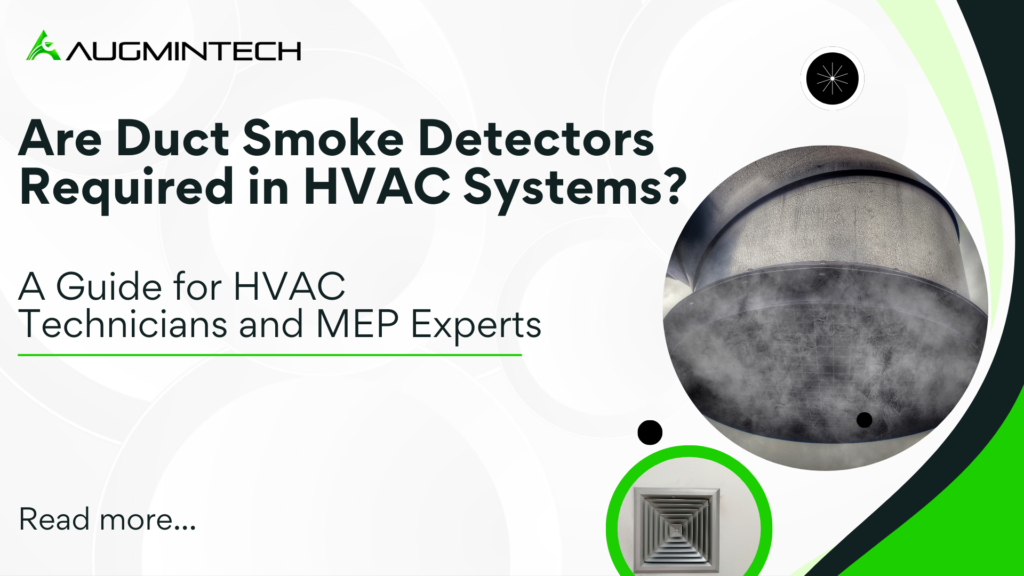Are Duct Smoke Detectors Required in HVAC Systems? A Guide for HVAC Technicians and MEP Experts
- January 4, 2025
- 3:59 pm
- 27000+ Comments

In modern building design, safety and compliance are paramount. Among the critical components of safety systems are duct smoke detectors, a key feature in many HVAC systems. But are these detectors always required? Understanding when and where duct smoke detectors are mandated can save time, ensure compliance, and enhance the safety of a building. This guide will provide clarity on their necessity, installation criteria, and best practices for HVAC technicians and MEP (Mechanical, Electrical, and Plumbing) experts.
Table of Contents
What Are Duct Smoke Detectors?
Duct smoke detectors are devices installed within HVAC ducts to detect smoke. They play a pivotal role in preventing the spread of smoke through ventilation systems during a fire, safeguarding occupants and minimizing damage. These detectors often integrate with fire alarm systems, triggering alerts and enabling safety measures such as shutting down fans or activating dampers.
Are Duct Smoke Detectors Required in HVAC Systems?
Code Compliance and Regulations
The requirement for duct smoke detectors is dictated by national and local building codes, such as:
NFPA 90A (Standard for the Installation of Air-Conditioning and Ventilating Systems): Mandates smoke detectors in HVAC systems exceeding 2,000 CFM (Cubic Feet per Minute) and in systems serving multiple floors.
International Mechanical Code (IMC): Requires smoke detectors for units over specific airflow thresholds and in return air systems.
Local authorities often adopt these codes but may impose additional requirements. Always verify with the Authority Having Jurisdiction (AHJ).
Situations Requiring Duct Smoke Detectors
High Airflow Systems: Systems exceeding 2,000 CFM typically require duct smoke detectors.
Multi-Zone Buildings: Buildings with multiple zones or floors need detectors to prevent smoke from traveling between areas.
Critical Occupancies: Hospitals, schools, and other critical facilities often require enhanced smoke detection due to high occupancy and risk factors.
Key Installation Considerations
Placement
Supply and Return Ducts: Install detectors in both supply and return ducts to cover the entire airflow system.
Upstream of Filters: Ensure detectors are placed upstream of filters to catch smoke before it disperses.
Maintenance
Schedule regular cleaning to prevent dust accumulation.
Test detectors periodically as per manufacturer guidelines to ensure functionality.
Integration
Connect duct smoke detectors to the building’s fire alarm system for centralized monitoring.
Incorporate shutdown mechanisms for HVAC fans and dampers.
Common Questions Answered
Typically, no. Residential HVAC systems often do not exceed airflow thresholds requiring smoke detection. However, luxury homes with complex systems may need them.
Non-compliance can result in fines, failed inspections, or, worse, compromised safety during a fire.
Yes, retrofit options are available, but professional assessment and installation are recommended to meet compliance and ensure proper integration.
Real-Life Tips for HVAC Technicians
Perform Pre-Installation Assessments: Review system airflow rates and building occupancy to determine detector requirements.
Consult with AHJs Early: Avoid compliance issues by confirming local code requirements before installation.
Prioritize Maintenance: Offer clients maintenance packages to keep detectors functional and compliant.
Educate Clients: Inform building owners about the importance of duct smoke detectors and the risks of non-compliance.
Conclusion
Duct smoke detectors are a vital component of HVAC systems, ensuring safety and code compliance in various settings. While not always required, their strategic installation can save lives and prevent property damage. For HVAC technicians and MEP experts, understanding the requirements and best practices for these detectors is essential. By staying informed and proactive, you can deliver safe, efficient, and compliant systems for your clients.
Take the Next Step in Your HVAC Career
Ready to Excel in HVAC Design and Drafting? Our HVAC Design & Drafting Course provides the hands-on skills and industry knowledge you need to secure high-paying roles and advance in the field. From in-depth system design to real-world troubleshooting, our course has it all.
